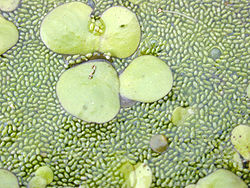Wolffia
| Wolffia | |
|---|---|
 | |
| Each speck is an individual plant | |
| Scientific classification | |
| Kingdom: | Plantae |
| Clade: | Tracheophytes |
| Clade: | Angiosperms |
| Clade: | Monocots |
| Order: | Alismatales |
| Family: | Araceae |
| Subfamily: | Lemnoideae |
| Genus: | Wolffia Schleid. |

Wolffia is a genus of aquatic plants with a cosmopolitan distribution.[1] They include the smallest flowering plants on Earth.[2] Commonly called watermeal or rootless duckweed,[3][4] these aquatic plants resemble specks of cornmeal floating on the water. They often float together in pairs or form floating mats with related plants, such as Lemna and Spirodela species.
Description
[edit]Wolffia are free-floating aquatic plants with fronds that are nearly spherical to cylindrical in shape and lack airspaces or veins.[1][3] They do not have roots.[1] Their rarely seen flowers originate from a cavity on the upper surface of the frond, and each flower has one stamen and one pistil.[1][3]
Although Wolffia can reproduce by seed, they usually use vegetative reproduction.[2] A mother frond has a terminal conical cavity from which it produces daughter fronds.[1]
Physiology
[edit]The growth rate of Wolffia varies within and among species. The rates of photosynthesis and respiration also vary proportionately to growth rate. The fastest growth rate (in fact, the fastest growth rate of any flowering plant) is shown by a clone of Wolffia microscopica, with a doubling time of 29.3 hours.[5]
As food
[edit]Wolffia are a potential high-protein livestock food source. One species, W. microscopica, is over 20% protein by dry weight and has high content of essential amino acids. They have historically been collected from the water and eaten as a vegetable in Asia.[6]
Species
[edit]
As of 2020[update], eleven species are accepted on Kew's Plants of the World Online:[1]
- Wolffia angusta Landolt
- Wolffia arrhiza (L.) Horkel ex Wimm.
- Wolffia australiana (Benth.) Hartog & Plas
- Wolffia borealis (Engelm.) Landolt
- Wolffia brasiliensis Wedd.
- Wolffia columbiana H.Karst.
- Wolffia cylindracea Hegelm.
- Wolffia elongata Landolt
- Wolffia globosa (Roxb.) Hartog & Plas
- Wolffia microscopica (Griff.) Kurz
- Wolffia neglecta Landolt
References
[edit]- ^ a b c d e f "Wolffia Horkel ex Schleid | Plants of the World Online | Kew Science". Plants of the World Online. Retrieved 5 July 2022.
- ^ a b "The Charms of Duckweed". 25 November 2009. Archived from the original on 25 November 2009. Retrieved 5 July 2022.
- ^ a b c "UC/JEPS: Jepson Manual treatment for WOLFFIA". ucjeps.berkeley.edu. Retrieved 5 July 2022.
- ^ "USDA Plants Database". plants.usda.gov. Retrieved 5 July 2022.
- ^ Sree, K. Sowjanya; Sudakaran, Sailendharan; Appenroth, Klaus-J. (11 September 2015). "How fast can angiosperms grow? Species and clonal diversity of growth rates in the genus Wolffia (Lemnaceae)". Acta Physiologiae Plantarum. 37 (10): 204. doi:10.1007/s11738-015-1951-3. ISSN 1861-1664. S2CID 255376153.
- ^ Appenroth, Klaus-J.; Sree, K. Sowjanya; Böhm, Volker; Hammann, Simon; Vetter, Walter; Leiterer, Matthias; Jahreis, Gerhard (15 February 2017). "Nutritional value of duckweeds (Lemnaceae) as human food". Food Chemistry. 217: 266–273. doi:10.1016/j.foodchem.2016.08.116. ISSN 0308-8146. PMID 27664634.
External links
[edit]- The Duckweed Genome Project Archived 2009-03-13 at the Wayback Machine from Rutgers University
- Armstrong, W. (2005). "Wayne Armstrong's treatment of the Lemnaceae". Palomar Community College District. Archived from the original on 16 May 2012. Retrieved 1 May 2011.
- Landolt, E. (1986) Biosystematic investigations in the family of duckweeds (Lemnaceae). Vol. 2. The family of Lemnaceae - A monographic study. Part 1 of the monograph: Morphology; karyology; ecology; geographic distribution; systematic position; nomenclature; descriptions. Veröff. Geobot. Inst., Stiftung Rübel, ETH, Zurich.


 French
French Deutsch
Deutsch